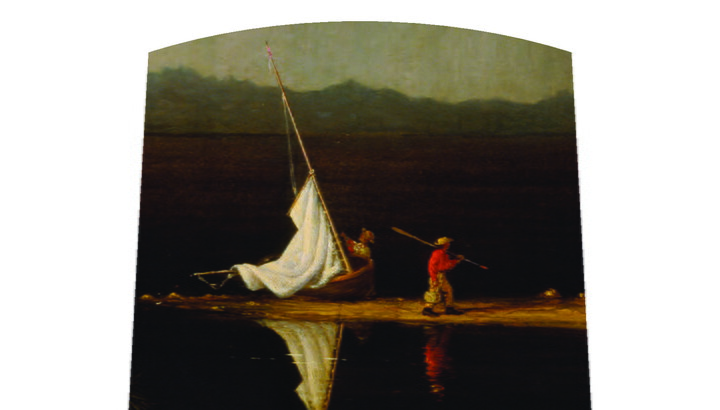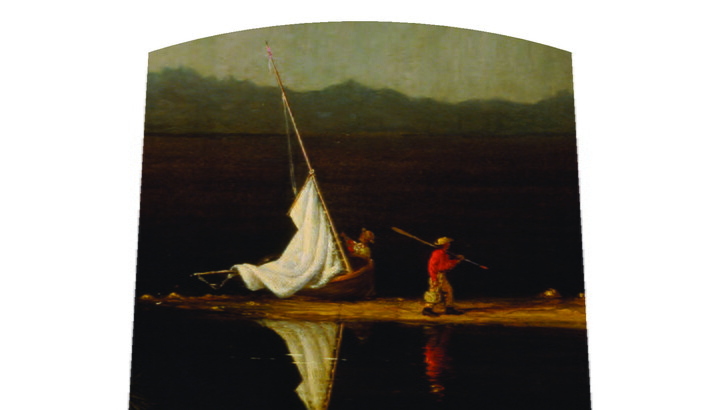


Artwork Images
Photo:
Controls
Thunder Storm on Narragansett Bay
Object Details
-
Date
1868
-
Object Type
Paintings
-
Medium
Oil on canvas
-
Dimensions
32 1/8 x 54 3/4 in.
-
Inscriptions
Recto:
signed and dated l.l.: M J Heade \ 1868.
-
Credit Line
Amon Carter Museum of American Art, Fort Worth, Texas
-
Accession Number
1977.17
-
Copyright
Public domain
Object Description
Nature has called an end to a day at sea. Storm clouds churn in a darkening sky, a lightning bolt strikes in the far distance, and sheets of rain chase sailboats back to shore. Yet despite the unsettled weather, the sailors remain calm. One furls the sails of his boat while his two companions walk unhurriedly up the beach, perhaps confident in the assurance that comes with a safe arrival on stable ground.
Between 1859 and 1868, Heade, a largely self-taught painter, completed at least eight canvases depicting storms. He frequently portrayed changing weather conditions in his art, and his storm scenes may have carried metaphorical significance. During the Civil War and in the early years of Reconstruction, thunderstorms, lightning bolts, and returning ships were used to symbolize the passage of the United States through an era of profound social turmoil.
—Text taken from the Carter Handbook (2023).
-
Wild Spaces, Open Seasons: Hunting and Fishing in American ArtOctober 7, 2017–January 7, 2018
Wild Spaces, Open Seasons brings together iconic works that explore outdoor subjects from the early 19th century to World War II, exploring American artists’ fascination with depicting a communion with nature that was receding in the face of industrialization.
-
From Remington to O’Keeffe: The Carter’s Greatest HitsOctober 6, 2018–March 22, 2019
During the renovation, this exhibition features highlights from the permanent collection, including paintings, photographs, and sculptures, by some of America’s most renowned artists.
Additional details
Location: On view
See more by Martin Johnson Heade
Tags
-
This dark seascape painted by Martin Johnson Heade in 1868 lives in an ornately carved, gold frame and is roughly 32 inches tall by 54 inches wide.
The artist places the viewer on a Rhode Island shoreline, looking at an extremely calm bay filled with several sailboats and land on the other side of the water. Dark, cloudy, ominous skies fill the top half of the canvas. A thin white, zigzagged lightning bolt cuts through the middle of the sky in the middle of the canvas, adding drama to the scene.
In the bottom foreground, there is a yellow sandy beach that has a cluster of beach grass on the left, wood pieces from a shipwreck in the middle of the beach, and lots of smaller rocks scattered across the entire beach. In the bottom center, three people appear. A shadowy figure messes with the sails of the boat behind the hull. A man on the left walks toward the right side of the painting down a sandbar away from a docked sailboat; he wears a hat, a red shirt, and light-colored pants. He rests an oar over one shoulder and holds a bucket by his side in his other hand. Ahead of him, farther right on the canvas, walks another man wearing a hat, a light-colored shirt, and red pants. He holds an oar in one hand down by his waist.
The beach extends into dark, very still water. Two boats with white sails float on the left, while the right side of the canvas has six boats with white sails, some closer to the viewer than others, and they face different directions. Above the water and land is the sky. The sky takes up about two thirds of the canvas. The boats on the left are under a gray, cloudy sky, while the boats on the right are caught in the middle of a downpour, indicated by the darker clouds over them, and vertical brush strokes imply rain. A lightning bolt separates the lighter sky on the left from the darker, stormy skies on the right. Four white birds and two black birds fly over the boats.
On the other side of the bay is a strip of land that is more visible on the left and starts to fade in the darkness of the storm as it reaches to the right side of the painting. The land is heavily wooded with broader strips of muted colors that represent buildings or houses. Above the land the sky fills up the rest of the canvas.
When this artist exhibited this painting, audiences did not know what to make of it because this stormy seascape was an uncommon theme for the artist and for landscapes and seascapes at the time.
-
How do colors found in nature influence an artist’s work?
How might artists portray mood or emotion in their work?
How might artists use weather/climate to convey a mood/feeling/emotion?
How are moods/emotions symbolic of an artist’s work?
How do current events influence subject matter in art?
-
Grades 3–5
Imagine yourself in one of the faraway boats. List some verbs that tell about the things you are doing (rowing, bailing, watching, paddling, hoping, worrying, yelling). List some adjectives that describe the sky and the water (dark, still, glassy, black, cloudy, scary, threatening, ominous).
Describe in complete sentences your experience in the boat. Be sure to include your five senses.
Imagine that you are one of the characters in this painting. Describe this experience from your point of view. Be sure to use your five senses.
Grades 5–8
Just as Heade used symbols to represent American identity during his lifetime, we are going to create symbols to represent the American identity during your lifetime. Choose one of Heade’s symbols from our discussion that you feel reflects American identity today. You may use it exactly like Heade or make changes. For example: If you choose clouds, what type of clouds will you represent? Why will you represent them in that way? If you choose a boat, is it broken or sailing freely?
Draw your chosen symbol on your paper. Now, create two of your own symbols. Next to your symbols, explain what each one represents.
Share Educator Resources
Amon Carter Disclaimer
This information is published from the Carter's collection database. Updates and additions based on research and imaging activities are ongoing. The images, titles, and inscriptions are products of their time and are presented here as documentation, not as a reflection of the Carter’s values. If you have corrections or additional information about this object please email us to help us improve our records.
Every effort has been made to accurately determine the rights status of works and their images. Please email us if you have further information on the rights status of a work contrary or in addition to the information in our records.
Related Works
-
A Closet Door, 1904-1906
John Frederick Peto
Oil on canvas
1983.158
-
Roseate Spoonbill, ca. 1980-85
Scott Gentling, Stuart Gentling
Graphite, opaque and transparent watercolor on paper
2018.26
-
Attention, Company!, 1878
William M. Harnett
Oil on canvas
1970.230
-
Drawing No. 18, 1919
Georgia O'Keeffe
Charcoal on paper
1997.2
-
Blips and Ifs, 1963-1964
Stuart Davis
Oil on canvas
1967.195
-
Zerogram, 2017
Ellen Carey
Dye coupler print
P2018.40
-
A Dash for the Timber, 1889
Frederic Remington
Oil on canvas
1961.381
-
Untitled, 1970
Luchita Hurtado
Lithograph
1970.86
-
Untitled #52, 2002
Laura Letinsky
Dye coupler print
P2007.3



